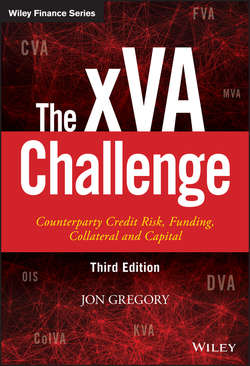Читать книгу The xVA Challenge - Gregory Jon - Страница 13
На сайте Литреса книга снята с продажи.
2
The Global Financial Crisis
2.5 A new world
ОглавлениеOther changes in derivative markets were also taking place. A fundamental assumption in the pricing of derivative securities had always been that the discounting rate could be appropriately proxied by LIBOR. However, practitioners realised that the OIS (overnight indexed spread) was actually a more appropriate discounting rate and was also a closer representation of the “risk-free rate”. The LIBOR–OIS spread had historically hovered around ten basis points, showing a close linkage. However, this close relationship had broken down, even spiking to around 350 basis points around the time of the Lehman Brothers bankruptcy. This showed that even the simplest types of derivative, which had been priced in the same way for decades, needed to be valued differently, in a more sophisticated manner. Another almost inevitable dynamic was that the spreads of banks (i.e. where they could borrow unsecured cash on a longer term than in a typical LIBOR transaction) had increased. Historically, this borrowing cost of a bank was in the region of a few basis points but had now entered the realms of hundreds of basis points in most cases.
It was clear that these now substantial funding costs should be quantified alongside CVA. The cost of funding was named FVA (funding value adjustment) which had the useful effect of consuming the strange DVA accounting requirements (from a bank’s point of view at least). Not surprisingly, the increase in funding costs also naturally led banks to tighten up collateral requirements. However, this created a knock-on effect for typical end-users of derivatives that historically have not been able or willing to enter into collateral agreement for liquidity and operational reasons. Some sovereign entities considered posting collateral, not only to avoid the otherwise large counterparty risk and funding costs levied upon them, but also to avoid the issue that banks hedging their counterparty risk may buy CDS protection on them, driving their credit spread wider and potentially causing borrowing problems. Some such entities posted their own bonds as collateral, solving the funding problems if not the counterparty risk ones. It also became clear that there was hidden value in collateral agreements that should be considered using collateral value adjustment (ColVA). Finally, the dramatic increase in capital requirements led to the consideration of capital value adjustment (KVA) and impending requirements to post initial margin to margin value adjustment (MVA).
Regulation aimed at reducing counterparty risk and therefore CVA was becoming better understood and managed. However, this in turn was driving the increased importance of other components such as DVA, FVA, ColVA, KVA and MVA. CVA, once an only child, had been joined by a twin (DVA) and numerous other relatives. The xVA family was growing and, bizarrely, regulation aimed at making OTC derivatives simpler and safer was driving this growth.
